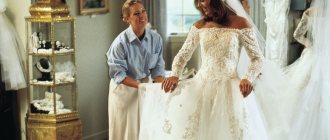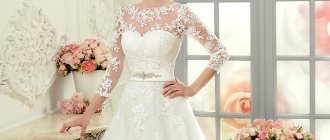Preparing for a wedding is always a whirlpool of tasks, a lot of changes and adjustments, a lot of advice from friends and relatives who strongly recommend implementation. In some cases, the “valuable” (as the advisers themselves believe) opinion of others can be neglected, but not always. To avoid controversial situations with loved ones - yours and your significant other, immediately outline the range of issues in solving which you are guided by your judgment. One of these questions is “Who should buy a wedding dress for the bride?”
Modern realities are devoid of any prejudices in this regard, but in a number of countries the implementation of ancestral customs is axiomatic and is not even discussed. In addition, some couples will prefer to follow the generally accepted rules regarding expenses before the wedding. What to do in your case? Below is food for thought that will help you decide on options for financing your wedding dress.
Buying a wedding dress for the bride: about the traditions of our ancestors
In the era of Rus', girls of marriageable age prepared their dowry, including a wedding dress, on their own. The wedding dress was made from the most expensive and beautiful fabric, generously decorated with ribbons, embroidery, beads and other decorations. The traditional color of the dress was considered red - “beautiful”: it symbolized the rich and happy life of the young. The skill and beauty of the finishing of the bride’s wedding dress determined how skilled the girl was in sewing, embroidery and other skills that were important at that time.
Over time, ancient customs lost their significance: in rich families, parents collected the dowry themselves, and dressmakers sewed the wedding dress for the bride. The trends in wedding attire also changed: red was replaced by pastel and traditional white shades, the fashion for which was introduced by Peter I. Against the backdrop of strengthening trade ties, more and more young people visited European countries and considered it their duty to bring newfangled decoration to brides. This is where the opinion came from that the groom should buy a wedding dress.
Organizing a wedding under the Soviet Union was completely different from how the ancestors of the “builders of communism” prepared for marriage. Preparation for the celebration took very little time - due to the mixing of traditions, the mass movement of young people from rural areas to the city, etc. The dress and suit were sewn in the studio, the veil and jewelry were bought in the store, and the event was celebrated in a nearby cafe or restaurant.
One thing is constant: it was undesirable for the groom to see his betrothed in a wedding dress before the wedding. Otherwise, an unhappy fate awaited the young people.
This is what the centuries-old chronicle of the wedding customs of our people looks like. How did you prepare for an important event in other countries? When did the groom and his family take on the purchase of the outfit? Read below.
Who buys a dress for the bride
Who buys a dress for the bride according to Russian traditions
Since ancient times, in Rus', brides purchased their wedding attire and prepared their trousseau on their own. For this they spared no effort, no time, no money. The dress for the wedding ceremony was very expensive, decorated with various accessories and embroidered patterns. At first it was only red. By the way the wedding dress was selected and decorated, the future husband and his relatives determined the degree of readiness of the girl for family life, her ability and skills as a housewife.
Time passed, and with it the old customs underwent changes. If the bride's parents had a lot of money, they did not bother their daughter with wedding problems and entrusted the preparation of the wedding dress to good tailors. And in the era of Peter the Great, it became fashionable to deliver wedding dresses from Europe. The grooms took on this pleasant mission. For their lovers, they brought light-colored dresses from Paris, Milan, Berlin, London and other famous European cities, which quickly became fashionable. Since then, a tradition has developed that the dress for the bride should be purchased by her gentleman.
In the Soviet Union, many good traditions lost their relevance, mixed with each other, or were even completely leveled out. Something similar happened with the purchase of a wedding dress. They began to prepare for the wedding in haste; outfits were sewn in ateliers, bought in stores, or even rented.
It was only believed that the groom should not have seen the bride’s dress until the wedding day, however, just like the bride did not know about the groom’s suit. If this tradition was violated, then the spouses were predicted to have a difficult life together.
Who buys a wedding dress for a bride in the modern world? There is no single answer to this question, so let's look at two main options.
Groom or his parents
The bride's wedding dress and numerous attributes for it are chosen and purchased by the groom's parents - this tradition has existed in the East for centuries. Fathers-in-law pay special attention to jewelry for the girl, which should mainly be gold. The richer the outfit, the better the future husband’s income, and the stronger his desire to marry this particular girl, residents of eastern countries believe.
If this option for purchasing a wedding dress suits your groom, invite your future mother-in-law to the salon. She will help you evaluate your choice from the outside, pointing out some nuances that a man in love is unlikely to notice. It’s also a good idea to involve your mother and your friends in this event.
Along with the wedding dress, it is convenient to purchase other wedding accessories: shoes, underwear, jewelry, and a cape.
The bride or her parents
If your family is firmly convinced that they should be involved in choosing and purchasing a wedding dress, without wasting time, go with your mother and friends to a wedding salon. It is better, of course, to listen to the opinion of your friends in this matter, since they are about the same age as you and are better versed in modern fashion trends than their elders. Choosing and purchasing a wedding dress takes a lot of time. To save some money, decide on the cut and style at home. Honestly analyze the shortcomings of your figure so that your wedding dress successfully neutralizes them.
Listen carefully to your mother’s advice, but first ask your father how much money you have.
Modern trends in buying a wedding dress
The question of who buys the bride a dress is not so relevant today. In most cases, newlyweds themselves create a wedding budget, from which they allocate money to purchase outfits. If the bride is an independent and independent girl, then she can take on not only the expenses for the wedding wardrobe, but also participate in paying for the banquet.
The most optimal solution is to allow the groom to pay for the rings, wedding bouquet and transportation. Today, bridal salons offer a variety of outfits and accessories, which can make it difficult to make a final choice. Be sure to pay attention to how your outfits will harmonize. It's good if they are made in the same style.
Contact a designer you know or order this service in a salon. A person who is well versed in modern fashion trends will give practical advice on buying a wedding dress and wedding suit. Correctly selected accessories, which with their similar elements will unite the outfits of young people, can smooth out some disunity in styles. A solution to the style problem will also be the opinion of the people organizing the wedding ceremony, whose professional skills you can trust.
Customs associated with buying a dress in other countries
In Europe, all wedding expenses are usually divided equally between the parties. As for the parents of the newlyweds, they practically do not take part in either financial or organizational matters. In Germany, if a couple decides not to get married, but simply to get married at the city hall, the bride buys an ordinary festive dress with her own money.
In the vastness of the modern East, the groom’s parents still buy a wedding dress, and in Brazil, the bride buys a wedding dress together with her family. The style of the dress should be light and open, appropriate to the weather conditions.
I would also like to say about the American tradition, where buying a wedding dress is unthinkable without purchasing two garters. The young husband takes one from his wife immediately after the painting and throws it to his single friends.
Groom's family
Until today, there is a strong belief that the groom is obliged to purchase a wedding dress with all the accessories (veil, shoes, bouquet, jewelry). Residents of Central Asian countries and the Caucasus observe this custom especially zealously. So, the groom's parents must prepare absolutely all the decorations, paying special attention to decorations. Earrings, rings, necklaces and bracelets should be made of pure gold - this will inform the invitees about the husband’s wealth and his desire to woo this particular girl.
How are things today? The future husband can defend the right to pay for the entire wedding dress for his beloved girl. Then, according to the rules of etiquette, it is reasonable to agree with his arguments by inviting his mother-in-law to the salon. This will show respect and lay a solid foundation for a normal relationship with your partner’s mother. Also take with you a friend or girlfriend whose opinion you value. To surprise your husband's mother, offer to "split" the cost of wedding supplies.
It is possible that the groom is ready to cover all the costs of the dress without regard to the cost. But even here it is worth showing prudence and frugality: “on the shore”, designate budget items for a veil, dress, jewelry, etc. If there are still restrictions on purchases, and you want to shine in a designer item, the best option is to provide funds from your own wallet.
The bride and her loved ones
For some girls, choosing the most important dress in life is extremely important and fundamental, even regarding payment. In this case, resolutely take on this task, enlisting the support of people dear to you - mother, sister, friend, etc. It is advisable to have several advisers nearby in order to objectively evaluate the dress and notice possible disadvantages of the outfit. Please also note that fitting may take a long time, and inform the “support team” about this. In order not to get lost in the variety of styles and styles in the salon, decide in advance on the desired models that will suit you.
What should you think about when buying a wedding dress? Of course, listen to the opinions of your mother and friends, weigh your financial capabilities and the price of the outfit, note how much it emphasizes your strengths and hides your shortcomings. You should not blindly chase fashion trends, but it is also advisable to take into account the main trends, especially if many young people are invited to the celebration.
Buying a wedding dress: who pays today?
The realities of life in the 21st century make their own adjustments, so the question “Who buys a wedding dress?” loses relevance. Often the bride and groom pay expenses from a common “treasury”; Often girls brought up in conditions of emancipation take full responsibility for purchasing an outfit, and all the expenses for relatives in addition.
If you are far from prejudices and outdated customs, offer your future husband to buy a ring, a bouquet, pay for car rental, etc. Preparations for a wedding take place approximately in this vein in European countries, where the line between the gender tasks of a man and a woman has long been erased. Moreover, the financial participation of the parents of the newlyweds is nominal.
In the fairy-tale East, the role of tradition is still strong: on her wedding day, the bride flaunts herself in the dress that her husband’s parents bought for her.
Residents of American states have long moved away from the original customs of organizing weddings, which is due to their rhythm of life and mixed origin.
Who should pay for the bride's wedding dress? It's up to you to decide! It is important to remember: if third parties will be involved in purchasing the outfit, agree in advance on the style and budget of the formal look, because Wedding dress suppliers have quite a wide selection and an unprepared person may get confused. This is the only way to avoid possible misunderstandings and create a festive mood before the event.
Where did signs and beliefs come from?
In the past, all the relatives gathered at weddings, and the life of the young couple was in full view of everyone.
Popular rumor quickly found a connection between how the wedding went and the relationships in the new family.
It is interesting that the signs were different in different areas: in some nations wedding dresses were passed down from generation to generation, in other countries the bride could only get married in her own new dress.
If during or after the ceremony the bride felt ill or fell ill, the reason was sought not in her health, but in the machinations of the sorcerers.
To protect the newlywed, they performed various ritual actions: they made protective stitches on the hem, offered to wear special herbs behind the corset that would protect against the evil eye, and did not allow strangers to touch the wedding dress.
The customs of each nation were inextricably linked with its history, culture and way of life.
In countries where flax was cultivated, the most common outfit for brides was linen wedding dresses, decorated with rich embroidery and embroidered with beads or pearls.
In countries where silk was produced, exquisite multi-layered silk robes were popular.
The main requirement for a young woman’s outfit was its unusualness and beauty, which could be manifested in color, cut, and selection of jewelry.











